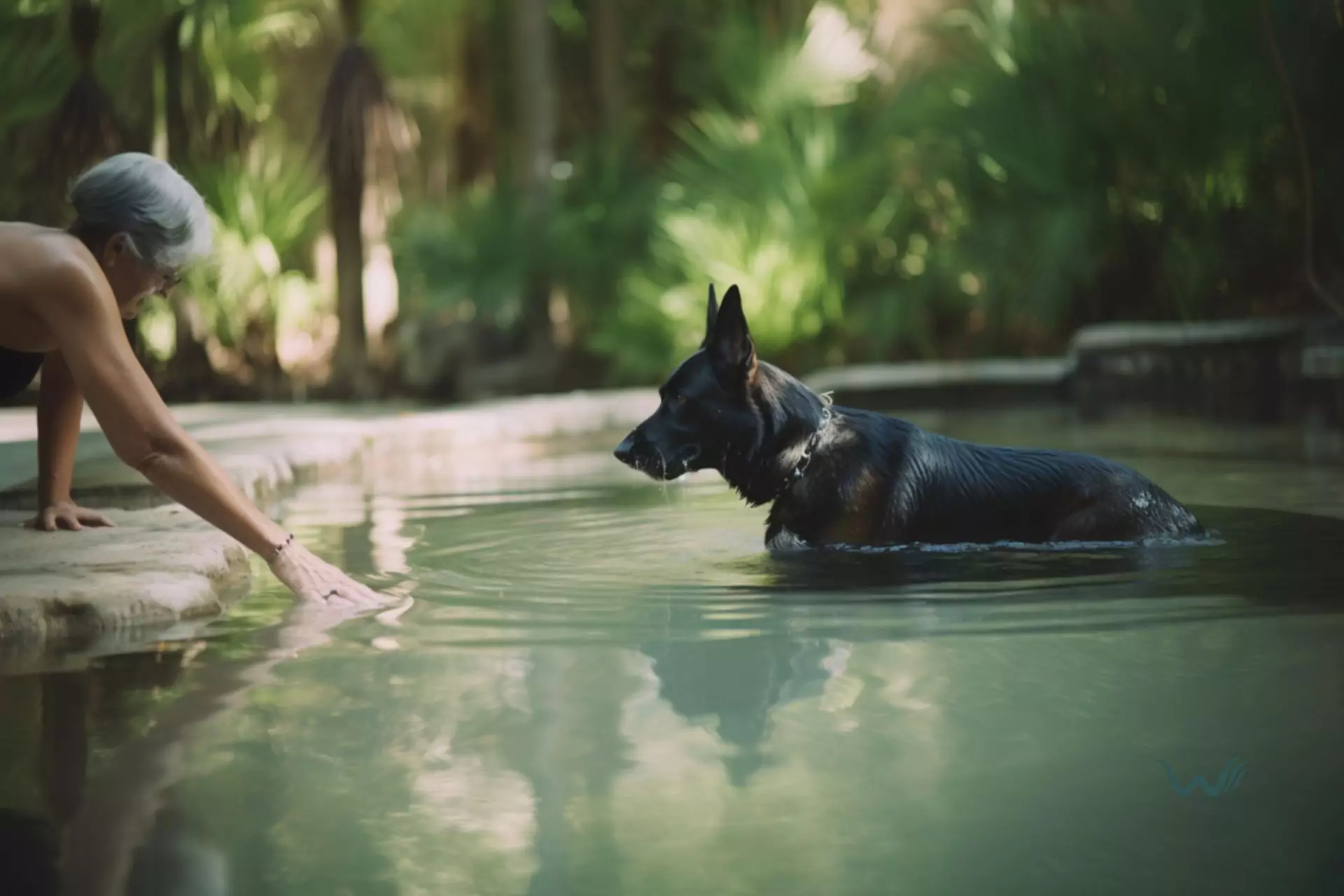

5 Tips For Teaching Your Dog How To Swim
by Haley Mills
Last updated: January 30, 2024
Verified and Approved by:
Angela Morris,
MSW, LCSW
Fact Checked

Do you have a furry friend who is eager to take a dip in the water? Teaching your dog how to swim can be a fun and rewarding experience for both of you. However, it’s important to ensure that your dog feels comfortable and safe in the water before diving in. In this article, we will provide you with five tips to help you teach your dog how to swim. From preparing your dog for the water to building confidence in the water, we’ve got you covered. So grab your swimsuit and your pup’s favorite toy, and get ready to make a splash together!
Before you start teaching your dog how to swim, preparing them for the water is crucial. This includes introducing them to the idea of swimming and getting them comfortable with the equipment and environment. Once your dog feels at ease near the water, you can gradually introduce them to the water itself. Start with shallow areas where they can touch the ground and slowly progress to deeper water. Remember, patience is key during this process. With time and practice, your dog will become a confident and skilled swimmer, ready to join you on all your water adventures.
Preparing Your Dog for the Water
Before you jump into the water with your dog, it’s important to make sure they are comfortable and prepared for their first swimming lesson. Not all dogs are natural swimmers, so it’s crucial to introduce them to the water slowly and patiently. Start by getting them used to the wet sensation by spraying them with a hose or filling a small kiddie pool for them to play in. This will help them become familiar with the feeling of water on their fur and paws. Additionally, it’s crucial to ensure that your dog is comfortable wearing a life jacket. Even if they are strong swimmers, a life jacket can provide extra buoyancy and peace of mind for you and your dog.
Once your dog is comfortable with being wet and wearing a life jacket, it’s time to introduce them to a larger body of water. Start with a shallow area where they can touch the bottom and gradually increase the depth as they become more confident. Be patient and provide lots of encouragement and positive reinforcement. It’s important to remember that not all dogs will take to swimming right away, so it’s crucial to go at their pace and never force them into the water. With time and patience, your dog will become more comfortable in the water and can enjoy swimming as a fun and healthy activity.
Introducing Your Dog to the Water
First, take your furry friend to a calm and shallow body of water, such as a lake or a pool. It’s essential to choose a location where your dog can easily touch the ground with their paws and feel comfortable. Before entering the water, it’s a good idea to let your dog explore the area and get used to the surroundings. Allow them to sniff and investigate the water’s edge so they can become familiar with the new environment. This will help them feel more at ease when it’s time to get in the water.
Once your dog seems comfortable and relaxed, slowly and gently guide them into the water. Start by walking alongside them and gradually increasing the depth. Be sure to offer plenty of praise and encouragement throughout the process. If your dog shows signs of anxiety or fear, take a step back and give them more time to adjust. It’s important to go at their pace and not force them into the water. Remember, this is a new experience for them and it’s essential to make it a positive one. With patience and consistency, your dog will soon become more confident in the water and enjoy swimming.
Teaching Basic Swimming Techniques
Once your pup is comfortable in the water, show them how to paddle their front legs and kick their back legs to move through the water. You can support them by holding them under their belly and gently guiding their movements. Encourage them with praise and treats when they make progress. It may take some time for them to get the hang of it, so be patient and keep practicing.
As your dog becomes more confident with their paddling and kicking motions, you can start to gradually let go of them and allow them to swim on their own. Stay close by, ready to assist if needed, but give them the opportunity to swim independently. Remember to always keep an eye on them and make sure they don’t venture too far from shore or get too tired. Swimming is an excellent form of exercise for dogs, but it’s essential to build up their stamina gradually to avoid exhaustion. With consistent practice and positive reinforcement, your dog will soon become a confident and skilled swimmer.
Building Confidence in the Water
To help your furry friend feel more comfortable in the water, gently introduce them to shallow areas and encourage them to explore at their own pace. Begin by finding a calm and quiet spot with shallow water, such as a beach or a calm lake. Walk into the water and show your dog that it is safe by calling them to join you. Use positive reinforcement, such as treats or praise, to reward them for taking small steps into the water. Make sure to go at their pace and never force them to go further than they are comfortable with. Allow them to sniff and investigate the water, and let them decide when they are ready to go deeper.
Once your dog is comfortable in shallow water, you can gradually move to deeper areas. Start by walking alongside them, keeping a close eye on their body language. If they show signs of stress or discomfort, such as trembling or trying to climb onto your back, bring them back to shallower water and try again later. As they gain more confidence, you can start encouraging them to paddle their legs while in the water. Use a toy or a treat to motivate them and make it a fun experience. Remember always to supervise your dog while they are swimming and never leave them unattended. Building confidence in the water may take time, but with patience and positive reinforcement, your furry friend will soon become a confident swimmer.
Can the Techniques Used to Teach a Dog to Roll Over be Applied to Teaching Them How to Swim?
Teaching a dog to swim involves a different set of techniques compared to teaching a dog roll over. While the basic principles of positive reinforcement and patience may apply, swimming requires more emphasis on building confidence and trust in the water. With the right approach, you can teach dog roll over, and then use similar positive reinforcement techniques to help them learn how to swim.
How Can I Teach My Dog to Swim in a Freshwater Tank?
If you’re looking to teach your dog to swim in a freshwater tank, follow a thorough freshwater tank setup guide. Start by acclimating your dog to the water and getting them comfortable in the tank. Always supervise them closely and provide positive reinforcement to encourage swimming.
Ensuring Safety Measures
Make sure you have all the necessary safety equipment on hand before taking your furry friend for a dip in the water. Just like humans, dogs can also encounter accidents or emergencies while swimming, so it’s crucial to be prepared. One essential piece of equipment is a dog life jacket. This will provide buoyancy and help your dog stay afloat in the water, especially if they are not yet confident swimmers. Look for a life jacket that fits your dog properly and has a handle on the back so you can easily grab and lift them out of the water if needed. Additionally, consider getting a dog-specific first aid kit that includes items such as antiseptic wipes, bandages, and tweezers. This will allow you to quickly address any minor injuries or scrapes that may occur during swimming sessions.
In addition to safety equipment, it’s essential to be aware of potential hazards in the water and take necessary precautions. Before allowing your dog to swim, ensure the water is clean and free from toxic substances or algae blooms. Dogs can become ill if they ingest contaminated water, so it’s essential to choose swimming spots that are safe for them. Keep an eye out for strong currents or undertows, as these can pose a danger to both you and your dog. If you’re unsure about the safety of a particular swimming area, it’s best to err on the side of caution and choose a different location. Ensuring you have the necessary safety equipment and being mindful of potential hazards can create a safe and enjoyable swimming experience for your furry friend.
The Next Lap
In conclusion, teaching your dog how to swim can be a fun and rewarding experience for both you and your furry friend. By following these five tips, you can ensure that your dog is well-prepared and confident in the water. Start by gradually introducing your dog to the water, using positive reinforcement and patience to help them overcome any fears or anxieties. Then, teach them basic swimming techniques and build their confidence through gradual progression. Lastly, always prioritize safety by using proper flotation devices and supervising your dog at all times. With time and practice, your dog will soon be swimming like a pro! So grab your swimsuit and get ready for some splashing good times with your pup!
Certify Your Emotional Support Animal Today

Why You Can Rely on Us?
At Wellness Wag, we believe your pet deserves care rooted in both science and compassion. Each article is carefully researched, written in clear language for pet owners, and then reviewed by qualified professionals to ensure the information is evidence-based, current, and practical for real-life care. Our goal is to help you feel confident in making informed decisions about your pet’s health and well-being.
Reviewed by
Angela Morris, MSW, LCSW
Angela is a licensed clinical social worker with 20 years of experience in patient advocacy and community mental health. She has assisted numerous clients with ESA evaluations and brings a deep understanding of disability accommodations, ensuring that all information is accurate, supportive, and practical.

Written by :
Haley Mills
Last Updated :
January 30, 2024











